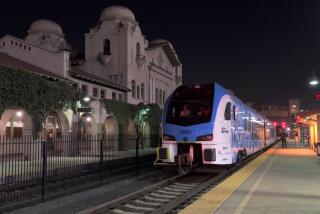Passenger Rail System in Canada Fights to Survive
VANCOUVER, Canada — The Canadian, the No. 1 train of Canada’s Via Rail system, rolled slowly into the station here the other day, 5 1/2 hours late on its run from Montreal. All things considered, it wasn’t too bad a trip. At least the train arrived.
In a country where rail travel has become a sometime thing--sometimes you make it, sometimes you don’t--just completing a trip is an accomplishment. Consider the record of the past few weeks.
Starting Feb. 8, there have been seven major wrecks on Canada’s rail system; 23 people were killed in one and 42 were injured in another. In addition to the human casualties, the economic loss is estimated in the millions of dollars and several of the wrecks threatened serious environmental damage because toxic material was dumped into waterways.
A century ago, Canadian railroads united this vast country. And once, Canadian railroads boasted a passenger service that was highly regarded in terms of speed, luxury and comfort. But it is hard to find traces of that vaunted system today.
So poor is the railroads’ present state that Cedric Jennings, Via Rail’s chief spokesman, said Canada’s passenger train service “is 10 years behind Amtrak,” the struggling American system.
Via Rail is not only behind Amtrak; it is behind in its schedules, too. Nearly 20% of its trains in 1984 were late, arriving on the average 80 minutes behind schedule.
The long-distance record is even worse. In 1984, The Canadian, which is one of the showcase trains that run from Montreal to Vancouver through the spectacular scenery of Canada’s western mountains, was on time only 30% of the time. It was usually three hours late.
From the time that the first transcontinental train crossed Canada in 1885, the railroads were leaders in comfortable, even opulent, service. They carried gourmet dining cars, barbers and assorted other services to help the passenger while away the three days that it took to get from Montreal to the West Coast.
The railroads built some of North America’s finest hotels and resorts in the mountains for passengers who wanted to break the trip by stopping for a look at the breathtaking sights near Banff or Jasper. Some of the railroad stations were regarded as architectural marvels.
As in the United States, Canada’s passenger rail system began to deteriorate during World War II, and the process gained speed in the postwar years.
Faced with competition from airlines, buses and the private automobile, the trains began losing money. The country’s two major railroads, the Canadian Pacific and the Canadian National, began cutting back on service and services. Equipment was not replaced, and the railroads put increasing importance on freight at the expense of passengers.
Similar Process
In the United States, where a similar process had taken place, the government took over most passenger service in the 1960s, but Canada left the trains to Canadian Pacific and Canadian National until 1977, when Parliament created Via Rail to operate all passenger service.
But Via Rail was given no money for new equipment and had to run its trains on the old tracks with CP and CN crews. Further, it was saddled with old and expensive work rules and had to pay an inordinate amount of the cost of maintaining the tracks.
Not until 1981 did the federal government provide any money for new trains. Even so, only 10% of Via’s equipment now is less than 30 years old.
Today, a passenger can sample both the past excellence and the present frustration by riding The Canadian from Montreal to Vancouver. The train is made up of stainless steel cars acquired after World War II by CP Rail, and it makes its way across the country by running along the St. Lawrence Seaway, Lake Erie and Lake Ontario, then across the plains of Ontario, Manitoba and Saskatchewan and into the mountains of Alberta and British Columbia.
The trip now takes nearly four days, and during that time the passenger’s mood swings from depressed boredom during the hours of gazing at the plains provinces’ seemingly endless vistas of grain to elation that rises as the train makes its dizzying climb into the Rockies and Cascades.
A Typical Trip
A recent trip, described by the crew as typical, included all of the grandeur, boredom and even danger of modern rail travel in Canada.
The Canadian was 2 1/2 hours late by the time it reached Calgary, about two-thirds of the way to Vancouver, for what reason no crew member could say. People waiting for the train in Calgary waited in a tiny, dirty and overheated station in the basement of a downtown office complex. No one explained the delay to them.
The train itself was comfortable in an old-fashioned way. The bedrooms were clean and neat, and the club car, with wraparound windows and elevated domed section, was nearly empty; there were only about 100 passengers on the nine-car train.
In the dining car there were linen tablecloths and heavy stainless steel tableware. The food was mediocre, though hot and plentiful. One crew member with 30 years’ service said that one of the few improvements that had been made in recent years--a switch from wood-burning cook stoves to microwave ovens--was actually a step backward in quality.
Heating the cars is a constant problem, for Via Rail uses steam heat for its passenger cars and the subzero weather frequently causes the steam to liquefy and then to freeze. By the time the train descends from the mountains into the Frazer Valley east of Vancouver, it is usually coated with ice.
As it climbs though the awesome mountains, it also passes through avalanche country and, more often than not, the tracks are covered with snow that has rolled down the steep hillsides.
Stopped by Avalanches
On this trip, The Canadian was stopped at least three times between Calgary and Vancouver by avalanches, and this put it even further behind schedule. Actually, all three delays resulted from controlled avalanches caused by an army artillery battery that blasts the snow down from peaks in order to prevent even worse avalanches.
Immediately after The Canadian started up after its third delay, a huge avalanche broke loose and blocked the line behind it for 18 hours.
There is more to rail service here than the long-haul trains. Altogether, Via Rail operates several regional and intercity systems, including the so-called Quebec City-Windsor Corridor. Along the corridor move the heavily used trains that serve Montreal, Toronto, Quebec City and Ottawa. All told, Via Rail operates nearly 1,800 trains a year.
The system’s only new equipment is in use in the corridor: sleek, turbo-powered trains bought in 1981 and finally operating successfully after several years of breakdowns and mishaps due to poor design and manufacturing defects.
But, despite the new trains, service in the corridor in 1984 was on time only 82% of the time, with an average delay of 39 minutes.
Via Rail officials hope that passenger trains have a promising future in Canada. They plan to improve both equipment and service, and they say that if the system, with all of its problems, can carry 300,000 passengers a year on its 11,400 miles of track, they should go on from survival to prosperity.
Pressured by Government
There is no choice. The federal government, which subsidizes Via Rail to the extent of several hundred million dollars a year ($600 million this year, covering two-thirds of Via’s operating costs), has ordered Via Rail to reduce its operating losses within two years or face such heavy cutbacks that some service will have to be curtailed and some eliminated.
Via officials have a long-range investment plan to buy new equipment, build new maintenance facilities and improve tracks and other facilities--at a cost of roughly $5 billion. Several hundred million dollars has already been spent for new equipment, but the government has said in effect that money will be held up unless Via Rail can prove that it is an essential and efficient service.
Pierre A. H. Franche, who just resigned as Via Rail’s president, said recently that no national railroad anywhere in the world makes money on its passenger service. “I believe Canada’s passenger railway can in the years to come be brought close to a break-even,” he added. “I for one cannot believe that Canada, a nation which spanned a continent with passenger rail, through some of the most difficult country and one of the worst winters on Earth, must now tamely give up and go out of the passenger railway business. . . . Can we not pioneer again?”
More to Read
Sign up for The Wild
We’ll help you find the best places to hike, bike and run, as well as the perfect silent spots for meditation and yoga.
You may occasionally receive promotional content from the Los Angeles Times.






